Surface Quasi-Geostrophic (SQG) Model¶
Here will will use pyqg to reproduce the results of the paper: I. M. Held, R. T. Pierrehumbert, S. T. Garner and K. L. Swanson (1995). Surface quasi-geostrophic dynamics. Journal of Fluid Mechanics, 282, pp 1-20 [doi:: http://dx.doi.org/10.1017/S0022112095000012)
import matplotlib.pyplot as plt
import numpy as np
from numpy import pi
%matplotlib inline
from pyqg import sqg_model
Vendor: Continuum Analytics, Inc.
Package: mkl
Message: trial mode expires in 21 days
Vendor: Continuum Analytics, Inc.
Package: mkl
Message: trial mode expires in 21 days
Vendor: Continuum Analytics, Inc.
Package: mkl
Message: trial mode expires in 21 days
Surface quasi-geostrophy (SQG) is a relatively simple model that describes surface intensified flows due to buoyancy. One of it’s advantages is that it only has two spatial dimensions but describes a three-dimensional solution.
If we define \(b\) to be the buoyancy, then the evolution equation for buoyancy at each the top and bottom surface is
The invertibility relation between the streamfunction, \(\psi\), and the buoyancy, \(b\), is hydrostatic balance
Using the fact that the Potential Vorticity is exactly zero in the interior of the domain and that the domain is semi-infinite, yields that the inversion in Fourier space is,
Held et al. studied several different cases, the first of which was the nonlinear evolution of an elliptical vortex. There are several other cases that they studied and people are welcome to adapt the code to study those as well. But here we focus on this first example for pedagogical reasons.
# create the model object
year = 1.
m = sqg_model.SQGModel(L=2.*pi,nx=512, tmax = 26.005,
beta = 0., Nb = 1., H = 1., f_0 = 1., dt = 0.005,
taveint=1, twrite=400, ntd=4)
# in this example we used ntd=4, four threads
# if your machine has more (or fewer) cores available, you could try changing it
INFO: Logger initialized
INFO: Kernel initialized
Initial condition¶
The initial condition is an elliptical vortex,
where \(L\) is the length scale of the vortex in the \(x\) direction. The amplitude is 0.01, which sets the strength and speed of the vortex. The aspect ratio in this example is \(4\) and gives rise to an instability. If you reduce this ratio sufficiently you will find that it is stable. Why don’t you try it and see for yourself?
# Choose ICs from Held et al. (1995)
# case i) Elliptical vortex
x = np.linspace(m.dx/2,2*np.pi,m.nx) - np.pi
y = np.linspace(m.dy/2,2*np.pi,m.ny) - np.pi
x,y = np.meshgrid(x,y)
qi = -np.exp(-(x**2 + (4.0*y)**2)/(m.L/6.0)**2)
# initialize the model with that initial condition
m.set_q(qi[np.newaxis,:,:])
# Plot the ICs
plt.rcParams['image.cmap'] = 'RdBu'
plt.clf()
p1 = plt.imshow(m.q.squeeze() + m.beta * m.y)
plt.title('b(x,y,t=0)')
plt.colorbar()
plt.clim([-1, 0])
plt.xticks([])
plt.yticks([])
plt.show()
/Users/crocha/anaconda/lib/python2.7/site-packages/matplotlib/collections.py:590: FutureWarning: elementwise comparison failed; returning scalar instead, but in the future will perform elementwise comparison
if self._edgecolors == str('face'):
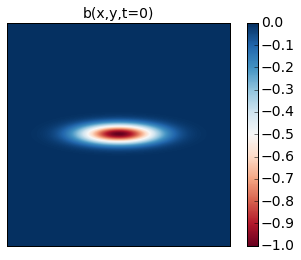
Runing the model¶
Here we demonstrate how to use the run_with_snapshots feature to
periodically stop the model and perform some action (in this case,
visualization).
for snapshot in m.run_with_snapshots(tsnapstart=0., tsnapint=400*m.dt):
plt.clf()
p1 = plt.imshow(m.q.squeeze() + m.beta * m.y)
#plt.clim([-30., 30.])
plt.title('t='+str(m.t))
plt.colorbar()
plt.clim([-1, 0])
plt.xticks([])
plt.yticks([])
plt.show()
INFO: Step: 400, Time: 2.00e+00, KE: 5.21e-03, CFL: 0.245
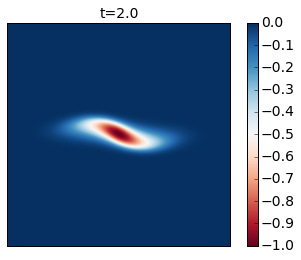
INFO: Step: 800, Time: 4.00e+00, KE: 5.21e-03, CFL: 0.239
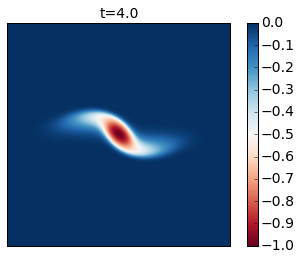
INFO: Step: 1200, Time: 6.00e+00, KE: 5.21e-03, CFL: 0.261
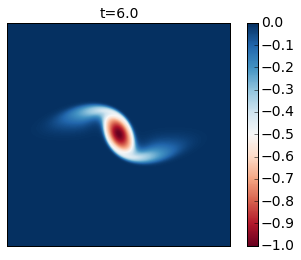
INFO: Step: 1600, Time: 8.00e+00, KE: 5.21e-03, CFL: 0.273
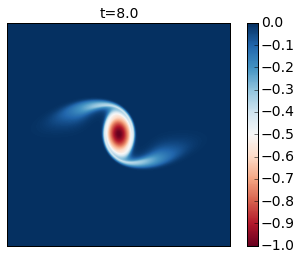
INFO: Step: 2000, Time: 1.00e+01, KE: 5.21e-03, CFL: 0.267
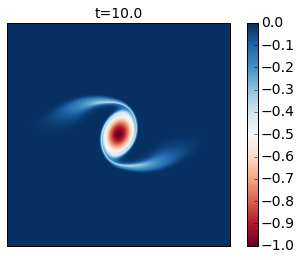
INFO: Step: 2400, Time: 1.20e+01, KE: 5.20e-03, CFL: 0.247
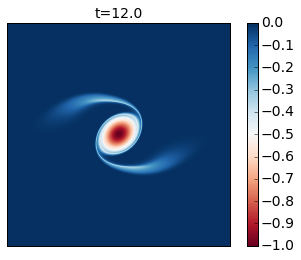
INFO: Step: 2800, Time: 1.40e+01, KE: 5.20e-03, CFL: 0.254
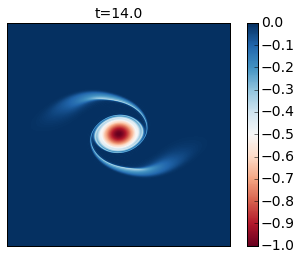
INFO: Step: 3200, Time: 1.60e+01, KE: 5.20e-03, CFL: 0.259
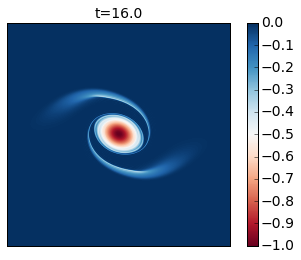
INFO: Step: 3600, Time: 1.80e+01, KE: 5.19e-03, CFL: 0.256
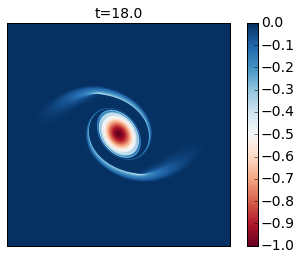
INFO: Step: 4000, Time: 2.00e+01, KE: 5.19e-03, CFL: 0.259
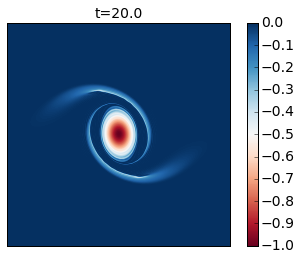
INFO: Step: 4400, Time: 2.20e+01, KE: 5.19e-03, CFL: 0.259
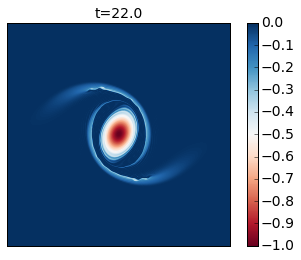
INFO: Step: 4800, Time: 2.40e+01, KE: 5.18e-03, CFL: 0.242
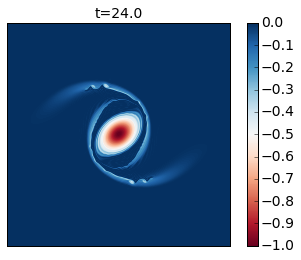
INFO: Step: 5200, Time: 2.60e+01, KE: 5.17e-03, CFL: 0.263
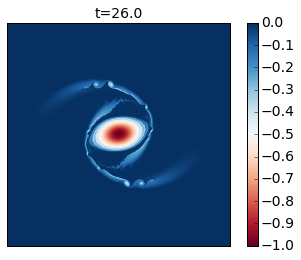
Compare these results with Figure 2 of the paper. In this simulation you see that as the cyclone rotates it develops thin arms that spread outwards and become unstable because of their strong shear. This is an excellent example of how smaller scale vortices can be generated from a mesoscale vortex.
You can modify this to run it for longer time to generate the analogue of their Figure 3.